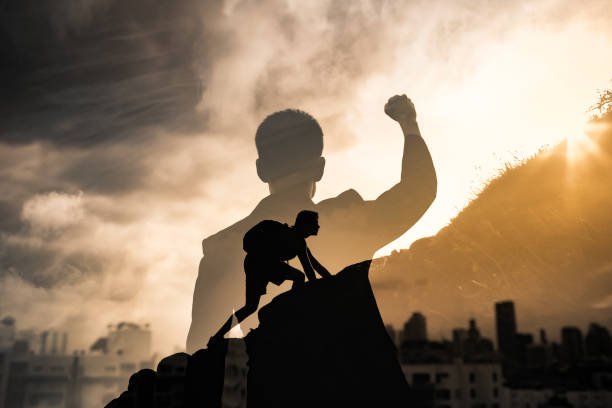Ever been halfway up a rocky, technical climb and felt every single sharp edge through the bottom of your shoe? Or maybe you’ve had that heart-stopping moment of slippage on a wet, root-covered descent? If you’re nodding along, you know that rugged trails demand more than just grit; they demand the right gear.
Hey, I’m one of you. A trail runner who lives for the challenge of untamed paths. I’ve spent years testing, trashing, and triumphing in countless pairs of shoes. I know the frustration of finishing a run with battered feet and the pure joy of flying over technical terrain with absolute confidence.
That feeling of confidence is what this is all about. Your shoes are your connection to the earth, your tires on the trail. When the ground gets gnarly, they are the single most important piece of gear you own. That’s why I’ve poured my experience into creating this definitive guide to the best trail running shoes for rugged terrain. Forget slipping, sliding, and sore feet. Let’s find you the perfect pair to unlock your most epic adventures yet.
Table of Contents
1. The Grip Monster: Hoka Speedgoat 5
If trail running shoes had a hall of fame, the Hoka Speedgoat would have its own wing. Named after legendary ultrarunner Karl “Speedgoat” Meltzer, this shoe is built to handle absolutely anything, for a very, very long time. It masterfully blends maximum cushioning with ferocious grip, a combination that was once thought impossible.
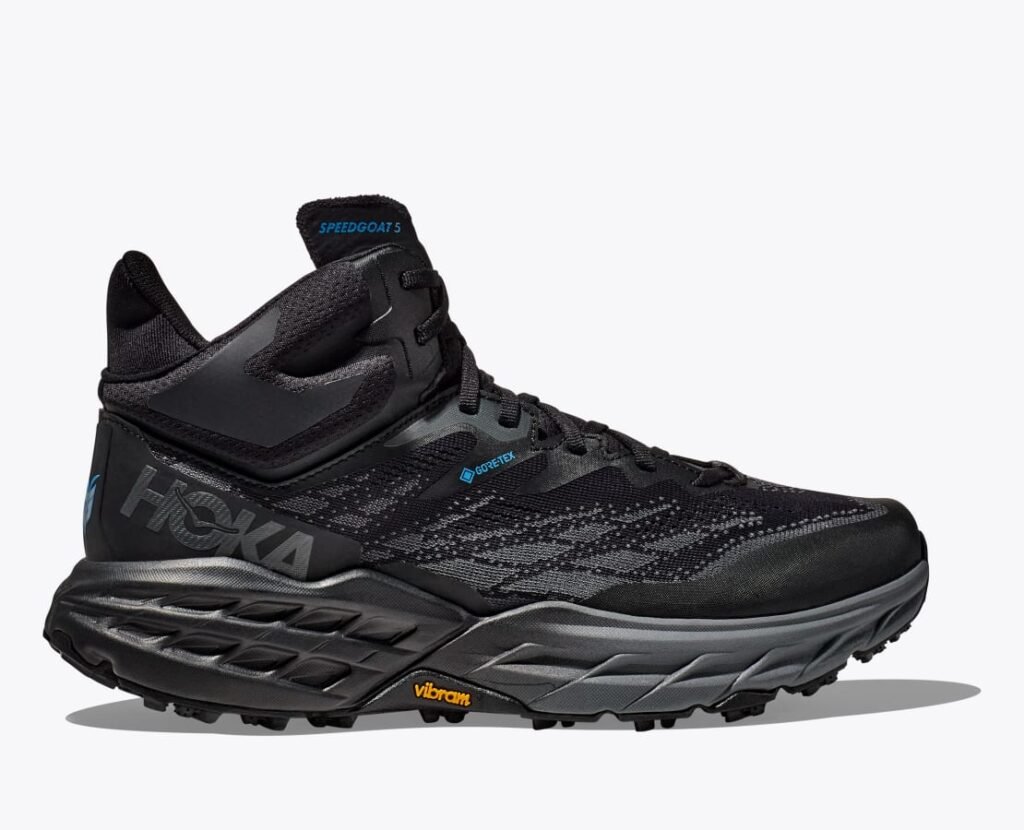
What Makes It a Beast on the Trail?
The magic starts from the ground up. Hoka equipped the Speedgoat 5 with a Vibram Megagrip outsole, which is the gold standard for sticky traction on both wet and dry rock. But they didn’t stop there. They added 5mm “Traction Lugs” – aggressive, multi-directional studs that bite into loose dirt, mud, and scree with incredible tenacity. Climbing feels more secure, and descending feels like you have a built-in braking system.
Above that monster outsole is Hoka’s signature stack of pillowy cushioning. This new, lighter CMEVA midsole foam absorbs impact like a dream. Running over a field of sharp rocks feels less like a minefield and more like a slightly bumpy road. This feature is a lifesaver for your joints on long-distance runs and ultramarathons, reducing fatigue and letting you run farther, more comfortably.
The upper has been revamped to a double-layer jacquard mesh that is both durable and more forgiving than previous versions, providing a snug, secure fit without being restrictive.
The Feel on the Trail
Slipping on the Speedgoat 5 feels like giving your foot a hug. It’s plush and comfortable from the get-go. On the trail, that cushioning works wonders to mute the harshness of the terrain, while the aggressive outsole gives you the confidence to bomb downhills you might have hesitated on before. It feels surprisingly nimble for such a cushioned shoe.
Pros:
- Unbeatable combination of max cushioning and aggressive traction.
- Vibram Megagrip outsole provides phenomenal grip.
- Reduces fatigue on long and ultra-distance runs.
- Comfortable and secure fit.
Cons:
- The high stack height might feel unstable to runners used to more minimalist shoes.
- Can feel a bit warm in very hot climates.
Best For: Runners who prioritize comfort on long, grueling runs across rocky and technical terrain. It’s the ultimate ultramarathon workhorse.
2. The Technical Virtuoso: La Sportiva Bushido II
When the trail turns from a path into a puzzle of rocks, roots, and steep angles, you need precision. You need a shoe that feels like an extension of your foot. Meet the La Sportiva Bushido II. Hailing from a brand with deep roots in mountaineering, the Bushido II is a lean, mean, mountain-running machine.
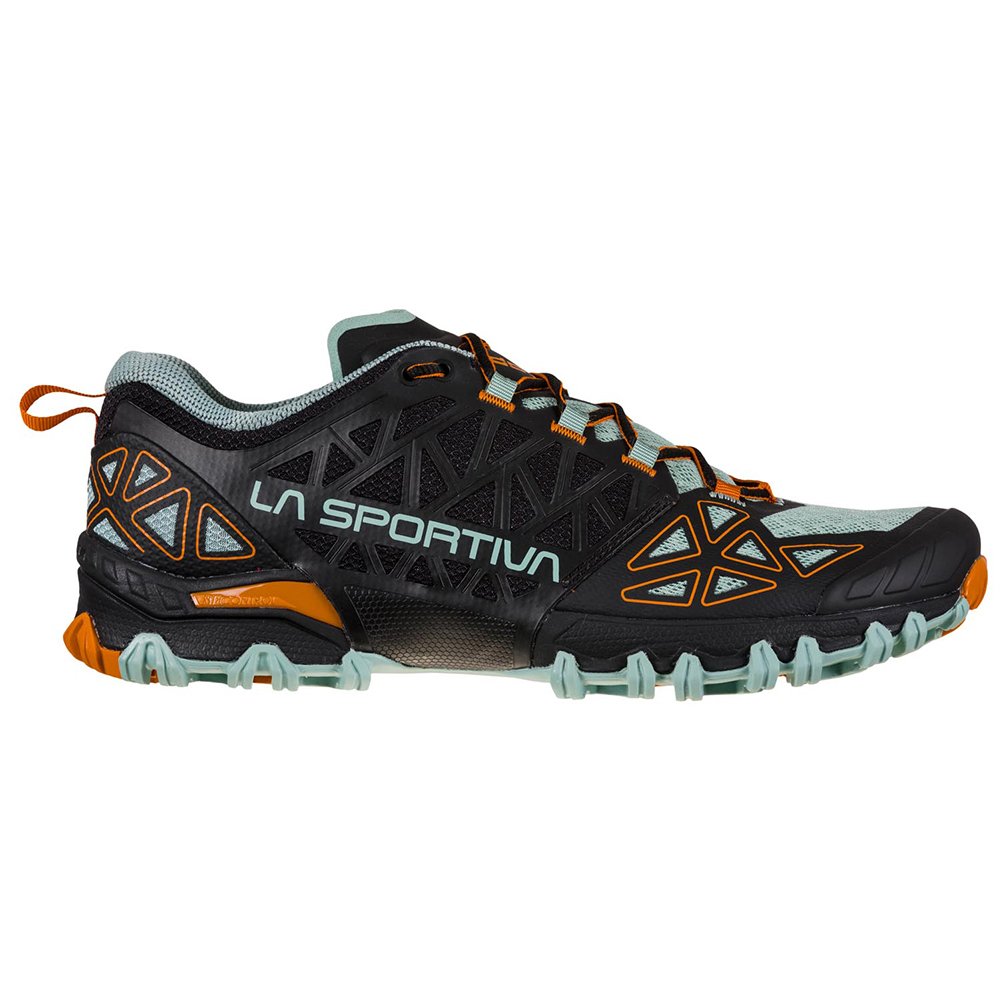
What Makes It a Beast on the Trail?
The Bushido II isn’t about pillowy softness; it’s about control and stability. The outsole is a work of art, featuring La Sportiva’s dual-compound FriXion XT rubber. The lugs on the outside edge of the shoe are designed to wrap upwards, creating an incredible contact surface when you’re traversing steep hillsides or scrambling over rocks.
The real genius lies in the “STB Control” system. TPU frames wrap under the arch and integrate with the upper, creating a locked-down, incredibly stable fit. Your foot simply does not move inside this shoe. This stability, combined with a rock guard in the forefoot, gives you the confidence to plant your foot on any surface without fear of twisting an ankle or getting a stone bruise.
Compared to the Speedgoat, the Bushido II is much lower to the ground. This provides an excellent “trail feel,” allowing you to react quickly to changes in terrain. It’s the sports car to the Speedgoat’s luxury SUV.
The Feel on the Trail
Running in the Bushido II feels precise and agile. You feel connected to the ground beneath you, able to make micro-adjustments on the fly. It excels on off-camber trails and during technical scrambles where foot placement is critical. The protection is ample for its weight, and the grip on dry rock is second to none.
Pros:
- Exceptional stability and lockdown.
- Phenomenal grip, especially on technical rock and traverses.
- Durable construction built for mountain abuse.
- Provides excellent trail feel and responsiveness.
Cons:
- The fit is notoriously narrow, so wide-footed runners should look elsewhere.
- Cushioning is firm and may not be enough for those who prefer a softer ride.
Best For: Runners who tackle highly technical, rocky, and mountainous terrain where agility, precision, and stability are more important than maximum cushioning.
3. The Natural Freedom Fighter: Altra Lone Peak 8
For a growing tribe of runners, the natural movement is the best movement. Altra has built its entire brand on this philosophy, and the Lone Peak is their legendary flagship. This shoe is for those who want to let their feet do what they were born to do, even on the most rugged ground.
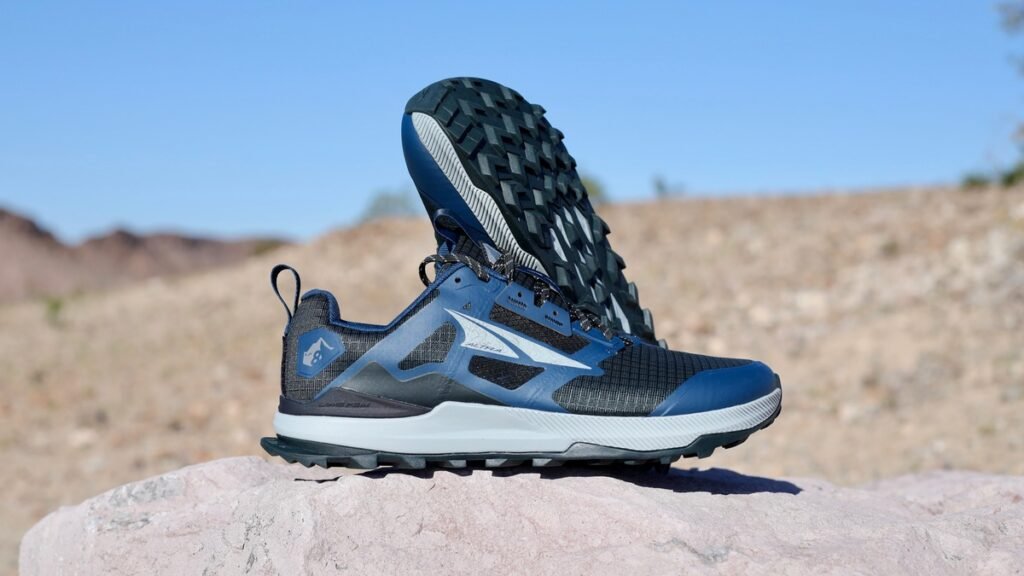
What Makes It a Beast on the Trail?
Two things define every Altra shoe: a Zero-Drop platform and a FootShape toe box. Zero-Drop means your heel and forefoot are at the same distance from the ground, promoting a more natural midfoot strike and better posture. The FootShape toe box is wide and anatomically shaped, allowing your toes to splay out naturally for better balance and power.
Don’t mistake “natural” for “weak.” The Lone Peak 8 is built tough. It features a MaxTrac outsole with a multi-directional lug pattern that provides solid grip on a wide variety of surfaces, from dusty hardpack to moderate mud and rock. It also includes a flexible, embedded StoneGuard that deflects sharp objects underfoot without making the shoe feel overly stiff.
The EGO midsole provides a ride that is the perfect middle ground – it’s responsive and cushioned enough to take the edge off the trail, but not so thick that you lose your connection to it.
The Feel on the Trail
Running in the Lone Peak 8 feels liberating. The wide toe box is a revelation for many, eliminating cramped toes and reducing the risk of blisters. The zero-drop platform encourages a quicker, lighter cadence. It feels capable and dependable across a huge range of conditions, making it a true do-it-all option for the runner who loves the feel of the trail.
Pros:
- FootShape toe box provides unmatched comfort and toe splay.
- Zero-drop platform encourages natural running mechanics.
- Great balance of cushioning, protection, and trail feel.
- Extremely versatile for various types of terrain.
Cons:
- Zero-drop can take time to adapt to if you’re coming from traditional shoes (10-12mm drop).
- Grip is very good, but might not match the hyper-aggressive lugs of the Speedgoat in deep mud.
Best For: Runners who want a more natural-feeling shoe with a wide toe box. It’s perfect for everything from day hikes to 100-mile races on varied, rugged terrain.
4. The Mud-Shedding Brawler: Salomon Speedcross 6
Some trails are just plain mean. They’re deep with mud, slick with wet grass, and covered in loose, soft dirt. For these conditions, you don’t just need grip; you need claws. The Salomon Speedcross 6 is that shoe. It’s an icon of the sport, famous for its unapologetically aggressive design.
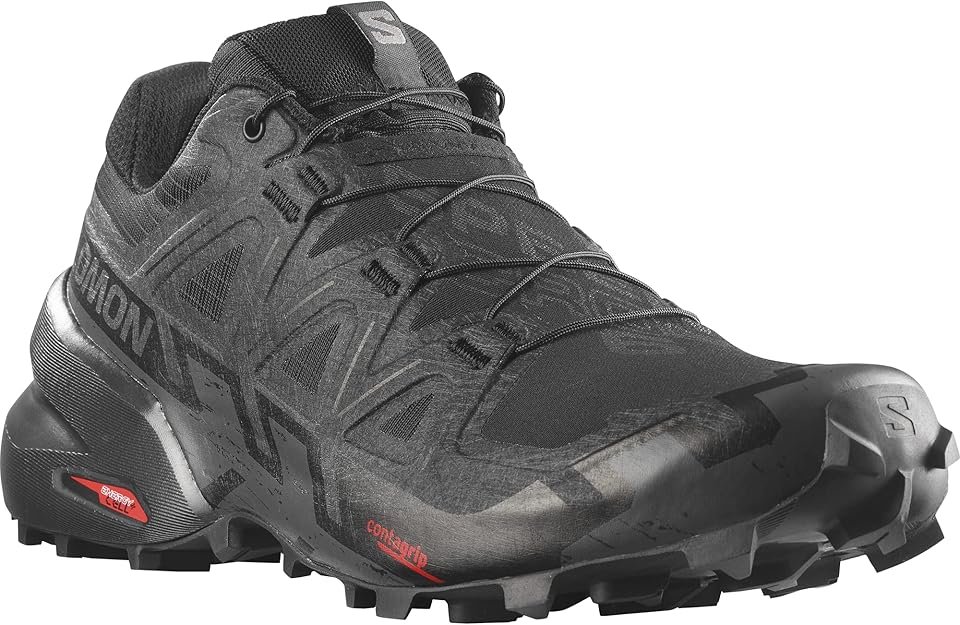
What Makes It a Beast on the Trail?
It’s all about the lugs. The Speedcross 6 features a Mud Contagrip outsole with deep, widely spaced, chevron-shaped lugs. This design serves two purposes: first, it bites deep into soft surfaces like a set of teeth, providing unparalleled traction. Second, the wide spacing allows mud to shed quickly, so the outsole doesn’t get clogged up and lose its effectiveness.
The upper is built with Salomon’s SensiFit technology, which cradles the foot from the midsole to the lacing system, providing a customized, secure fit. This is crucial for preventing your foot from sliding around when navigating steep and sloppy terrain. Combined with the famous Quicklace system, you can get a locked-in feel in seconds.
The EnergyCell+ midsole foam provides a decent amount of cushioning and excellent energy return, making the ride surprisingly comfortable for such an aggressive shoe.
The Feel on the Trail
Running in the Speedcross 6 on its intended terrain (mud, snow, soft ground) is a game-changer. You feel totally connected and in control. The confidence it inspires on slippery downhills is incredible. On harder surfaces like rock or pavement, the tall lugs can feel a bit awkward, but that’s not what this shoe was designed for. It’s a specialist, and it’s the best in its class.
Pros:
- Best-in-class grip on mud, snow, and soft terrain.
- Excellent foot lockdown and secure fit.
- Durable construction that handles abuse.
- Convenient and effective Quicklace system.
Cons:
- Overkill for hard-packed or rocky trails.
- Lugs can wear down faster if used frequently on abrasive surfaces.
Best For: Runners who frequently encounter deep mud, wet grass, snow, or loose dirt. It’s the ultimate weapon for sloppy conditions and obstacle course racing.
5. The Versatile All-Rounder: Saucony Peregrine 14
What if your trails have a bit of everything? A little hardpack, some rocky sections, a creek crossing, and a few muddy patches? You need a shoe that can handle it all without flinching. The Saucony Peregrine 14 is the swiss army knife of trail running shoes for rugged terrain.
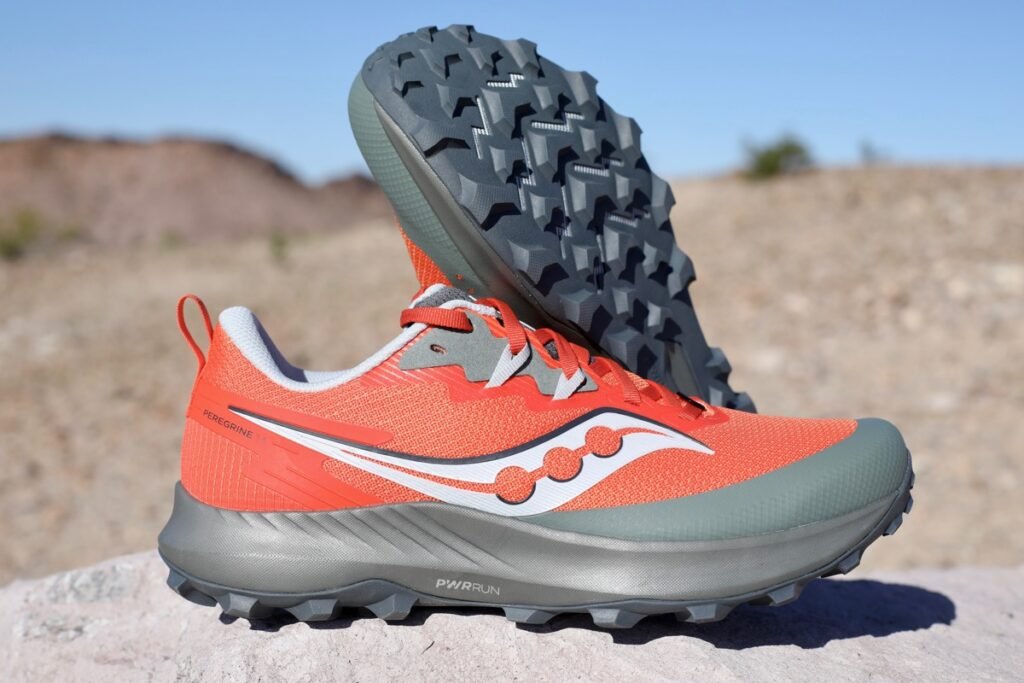
What Makes It a Beast on the Trail?
The Peregrine strikes a beautiful balance between all the key elements of a great trail shoe. The PWRTRAC outsole has 5mm lugs that are aggressive enough for solid grip in loose stuff but are shaped and spaced in a way that they also feel good on firmer ground.
For protection, it features a flexible woven rock plate that conforms to your foot, shielding you from sharp objects without creating a stiff, board-like feeling underfoot. This is paired with a comfortable bed of PWRRUN cushioning that is responsive and protective enough for daily runs and mid-distance races.
The upper is a durable, breathable mesh with supportive overlays, providing a secure and comfortable fit that’s ready for the long haul. With a modest 4mm drop, it’s an easy shoe for most runners to get along with.
The Feel on the Trail
The Peregrine 14 just feels right on a huge variety of trails. It’s nimble and responsive enough for you to dance through technical sections, but has enough cushioning and protection to keep your feet happy as the miles add up. It’s the shoe you can grab without checking the weather or trail conditions, knowing it will perform admirably.
Pros:
- Excellent all-around performance on mixed terrain.
- Great balance of grip, cushion, and protection.
- Flexible rock plate offers protection without stiffness.
- Comfortable and secure fit.
Cons:
- While a jack-of-all-trades, it may not excel in one specific area like a specialist shoe (e.g., not as much cushion as the Hoka, not as much mud-grip as the Salomon).
Best For: The trail runner who does it all. If your weekly runs include a mix of different surfaces and you want one shoe that can confidently handle whatever you throw at it, the Peregrine 14 is a top contender.
Your Rugged Terrain Shoe Questions, Answered (FAQ)
Choosing the right shoe can bring up a lot of questions. Here are answers to some of the most common ones I hear from fellow runners.
Q1: How often should I replace my trail running shoes?
This is the million-dollar question! There’s no single answer, but a good rule of thumb is to replace them every 300 to 500 miles (500 to 800 kilometers).
However, mileage isn’t the only factor. Pay attention to how your shoes look and feel. Look for visible signs of wear: Are the lugs on the outsole worn down and flat? Is the midsole foam compressed, with deep creases, and does it feel “dead” or unresponsive? Are there rips or tears in the upper where your foot might not be held securely? If you start feeling new aches and pains in your feet, knees, or hips after a run, it’s often a sign that your shoes’ cushioning and support are gone.
Q2: Are waterproof (Gore-Tex/GTX) trail shoes a good idea?
It depends entirely on your typical running conditions. Waterproof shoes are fantastic for keeping your feet dry from external moisture like rain, shallow puddles, and snow, making them great for cold or consistently wet climates.
However, they have two main drawbacks. First, they are far less breathable, which can lead to hot, sweaty feet in warmer weather. Second, once water gets inside a waterproof shoe (like from a deep stream crossing that goes over the ankle), it has nowhere to go. Your shoe becomes a waterlogged bucket, which is a recipe for blisters. Non-waterproof shoes, by contrast, will drain and dry out much, much faster. For most runners in varied conditions, a standard, breathable shoe is the more versatile choice.
Q3: Do I really need a shoe with a rock plate?
For truly rugged, rocky, and root-filled terrain, a rock plate is an absolute game-changer. It’s a thin sheet of semi-rigid material (often TPU plastic or woven fiber) embedded in the midsole that acts as a shield, deflecting sharp objects and preventing painful stone bruises on the bottom of your foot.
If you run on softer dirt trails or less technical paths, you can easily get by without one. Also, some maximum-cushion shoes (like the Hoka Speedgoat) provide so much thick foam underfoot that the foam itself acts as protection, making a dedicated rock plate less necessary. But for confidence on technical terrain, a rock plate is a feature you’ll be thankful for.
Q4: Can I just use my road running shoes on rugged trails?
While you can technically wear anything you want, using road shoes on rugged trails is a bad idea for a few key reasons.
First, traction. Road shoes have flat, smooth outsoles designed for pavement. They offer almost no grip on dirt, mud, or wet rock, which is a huge safety risk. Second, durability. The lightweight, breathable mesh on road shoes will get shredded quickly by rocks and branches. Trail shoes use tougher, more durable uppers. Finally, protection. Road shoes lack features like toe bumpers and rock plates, leaving your feet vulnerable to the trail’s many hazards. It’s worth investing in a proper trail shoe for safety, performance, and comfort.
The Final Step: Finding Your Perfect Match
So, there you have it – five incredible shoes, each a champion in its own right. Choosing the best one comes down to you. Think about the trails you run most often. Are they rocky and mountainous like the domain of the La Sportiva Bushido II? Or are they soft and muddy, calling for the Salomon Speedcross 6?
Consider your personal preferences. Do you love the pillowy comfort and long-distance prowess of the Hoka Speedgoat 5? Or the natural freedom of the Altra Lone Peak 8? Or perhaps you need the do-it-all reliability of the Saucony Peregrine 14?
The right pair of trail running shoes for rugged terrain is out there, waiting to carry you on your next great adventure. Investing in the right footwear isn’t just about comfort; it’s about safety, confidence, and unlocking your full potential on the trail.
Now it’s your turn. Which of these shoes gets you excited to hit the trails? Do you have a trusted favorite for rugged terrain that I missed? Drop a comment below and share your experience! Also don’t forget to subscribe to MindGearMen.
Happy trails, and may your feet always find their footing.

